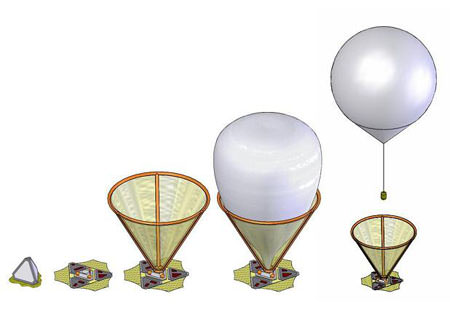[/caption]
A future Mars mission could include instruments attached to balloons, providing the capability to study places where rovers can’t go, while offering a closer look than orbiting satellites. NASA has awarded a Small Business Innovative Research (SBIR) Phase I contract to Aurora Flight Sciences and its partner Vertigo Inc, to develop an autonomous balloon launcher to operate from the surface of Mars. Aurora is looking to develop a compact lightweight system that could be included on future Mars landers, augmenting the mission with a small aerial vehicle. Such a system would have potential for atmospheric sampling and video data capture unavailable on current Mars missions.
Balloon-based Mars exploration has the capability to cover a larger portion of the Martian surface than is accessible via a rover and to provide better resolution than is available from satellites. Balloons could be used to measure atmospheric data at different altitudes and locations on Mars.
“A major challenge to ground deployment is the possibility of the envelope being damaged by winds, surrounding rocks, or parts of the associated lander,” said the project’s manager, George Kiwada. “Our Shielded Mars Balloon Launcher (SMBL) concept addresses this challenge by using inflatable structures to provide a safe environment for balloon inflation and deployment.”
Balloons have been flying for decades in Earth’s stratosphere, which has an atmosphere as thin as that on the surface of Mars. Conventional stratospheric balloons have lifetimes limited to a few days because of the daily heating and cooling of the balloon. Helium superpressure balloons, currently under development for the Ultra Long Duration Balloon (ULDB), will fly more than 100 days and perhaps as long as a year. Smaller superpressure balloons carrying payloads of only a few kilograms have already flown for as long as a year.
Aurora’s has done previous work with NASA on the development of a Mars airplane. In that project, Aurora became familiar with the challenges of aerial vehicle operations in the Martian atmosphere.
Source: Aurora Flight Sciences


This is great. A raised observation and sampling platform offers opportunites NASA hasn’t had to investigate Mars.
Hopefully, with this innovation, more can be learned about the red planet.
Awesome to check the great canyons areas and other areas no current or next generation rover safely capable of doing, and to check terrain about the monster Olympus Mons, if promsing, the next generation rovers can drill down and test.
What a brilliant idea. Perhaps some sort of flexible solar panel could be developed and cover the surface of the balloon for power. Maybe an electric heating system could be used to heat and cool the gas inside the balloon to control altitude. Due to the need for a light payload on each balloon, weight would probably allow several balloon probes per surface lander. Theoretically, we could place a lander on each face of the planet (East, West, North/South poles) with maybe 5 balloon probes each, all of which could be released at different times to allow for greater surface coverage. This is a highly economical system, and seems to hold a lot of potential.
I believe that others have already set into motion the idea of using an inflated balloon, coated on one side to use as a reflector to concentrate solar power onto a small module set inside the balloon for the production of electricity. That can also be easily applied to this idea. Then all you need to add is the facility to be able to change the density of the balloon by adding or subtracting gas as needed to be able to travel anywhere over the surface, particularly at the bottom of the deep Valley’s. Get it done. Now!
Could you use a balloon on a small rover, that can be inflated and deflated, that could be used to transport the rover large distances? You may not be able to control the direction too accurately. But at least after studying an area, you can move somewhere significantly far away in less time than driving.
Excellent – it’s all falling into place.
The air on the surface of Mars is about as thin as the air where our highest balloons can go – but Mars has but .38 gee gravity. So, what is the Earth altitude equivalent of a Mars balloon launch? I wish I could do that math.
And how long is one of these puppies gonna in a Martian dust storm? Or could they raise above it?